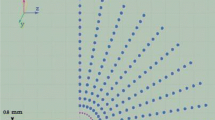Abstract
Objective
In this study, radial dosimetric characterization for specific internal geometry of seed source was determined. In this study, the separate contribution of radioactive components of the seed’s unlikely single radioactive rod on dose distribution was investigated using model seed TheraSeed 200 source at parallel shells in a water phantom.
Methods
TheraSeed 200 brachytherapy seed was modeled using EGSnrc-MP Monte Carlo simulation code. Dose contributions of radioactive components inside the seed were calculated on coaxial shells with different radii in a water phantom. Dose calculation points on shells were determined as only spatial. The study’s spatial geometrical approach was considered.
Results
Dose distributions of two radiation emitters were compared on plotted data. In 0°–90° rotation area, left emitter’s efficiency varied with distance. On shells with small radius, dose contribution (D1) of left emitter was weakly effective on total distribution; right emitter was the determinant factor on the total dose. By increasing shell radius, efficiency of two emitters comes close.
Conclusion
It seems that geometrical specification of a seed is markedly effective on dose distribution. Differences between doses of two radioactive materials decrease rapidly beyond the seed borders. Consideration of this study can be applied for other seeds that have multiple radiation emitters to research the effects of their geometrical specification on dose distributions.








Similar content being viewed by others
References
Mobit P, Badragan I. An evaluation of the AAPM–TG43 dosimetry protocol for I-125 brachytherapy seed. Phys Med. Biol. 2004;49:3161–70.
Rivard MJ, Melhus CS. Brachytherapy dosimetry parameters calculated for a new 103Pd source. Med Phys. 2004;31:2466–70.
Sloboda RS, Menon GV. Experimental determination of the anisotropy function and anisotropy factor for model 6711 I-125 seeds. Med Phys. 2000;27:1789–99.
Weaver K. Anisotropy functions for 125I and 103Pd sources. Med Phys. 1998;25:2271–8.
Rivard MJ, Coursey M, Larry A, Hanson WF. Update of AAPM Task Group No 43 Report: a revised AAPM protocol for brachytherapy dose calculations. Med Phys. 2004;31:663–74.
Taylor REP, Yegin G, Rogers DWO. Benchmarking BrachyDose: voxel based EGSnrc Monte Carlo calculations of TG-43 dosimetry parameters. Med Phys. 2007;34:445–57.
Monroe JI, Williamson JF. Monte Carlo-aided dosimetry of the Theragenics TheraSeed Model 200 103Pd interstitial brachytherapy seed. Med. Phys. 2002;29:609–21.
Taylor REP, Rogers DWO. Carleton laboratory for radiotherapy physics. http://www.physics.carleton.ca/clrp/seed_database/Pd103/TheraSeed_200/. Accessed 05 August 2009.
Camgöz B, Yeğin G, Kumru MN. Differential dose contributions on total dose distribution of 125I brachytherapy source. Rep Pract Oncol Radiother. 2010;15(3):69–74.
Author information
Authors and Affiliations
Corresponding author
Rights and permissions
About this article
Cite this article
Camgöz, B., Kumru, M.N. Investigation of dose distribution of TheraSeed 200 103Pd brachytherapy seed on coaxial cylindrical phantom shells using Monte Carlo simulation. Ann Nucl Med 25, 371–379 (2011). https://doi.org/10.1007/s12149-011-0472-4
Received:
Accepted:
Published:
Issue Date:
DOI: https://doi.org/10.1007/s12149-011-0472-4



